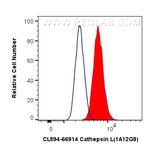Search Thermo Fisher Scientific
Proteintech
Cathepsin L Monoclonal Antibody (1A12G8), CoraLite® 594
FIGURE: 1 / 1
Cathepsin L Antibody (CL594-66914) in Flow

Product Details
CL594-66914
Species Reactivity
Host/Isotype
Class
Type
Clone
Immunogen
Conjugate
Excitation/Emission Max
Form
Purification
Storage buffer
Contains
Storage conditions
Shipping conditions
Product Specific Information
Immunogen sequence: MNPTLILAAF CLGIASATLT FDHSLEAQWT KWKAMHNRLY GMNEEGWRRA VWEKNVKMIE LHNQEYREGK HSFTMAMNAF GDMTSEEFRQ VMNGFQNRKP RKGKVFQEPL FYEAPRSVDW REKGYVTPVK NQGQCGSCWA FSATGALEGQ MFRKTGRLIS LSEQNLVDCS GPQGNEGCNG GLMDYAFQYV QDNGGLDSEE SYPYEATEES CKYNPKYSVA NDTGFVDIPK QEKALMKAVA TVGPISVAID AGHESFLFYK EGIYFEPDCS SEDMDHGVLV VGYGFESTES DNNKYWLVKN SWGEEWGMGG YVKMAKDRRN HCGIASAASY PTV
Target Information
The protein encoded by this gene is a lysosomal cysteine proteinase that plays a major role in intracellular protein catabolism. Its substrates include collagen and elastin, as well as alpha-1 protease inhibitor, a major controlling element of neutrophil elastase activity. The encoded protein has been implicated in several pathologic processes, including myofibril necrosis in myopathies and in myocardial ischemia, and in the renal tubular response to proteinuria. This protein, which is a member of the peptidase C1 family, is a dimer composed of disulfide-linked heavy and light chains, both produced from a single protein precursor. At least two transcript variants encoding the same protein have been found for this gene.
For Research Use Only. Not for use in diagnostic procedures. Not for resale without express authorization.
References (0)
Bioinformatics
Protein Aliases: Cathepsin L1; Major excreted protein; MEP; Procathepsin L
Gene Aliases: CATL; CTSL; CTSL1; MEP
UniProt ID: (Human) P07711
Entrez Gene ID: (Human) 1514

Performance Guarantee
If an Invitrogen™ antibody doesn't perform as described on our website or datasheet,we'll replace the product at no cost to you, or provide you with a credit for a future purchase.*
Learn more
We're here to help
Get expert recommendations for common problems or connect directly with an on staff expert for technical assistance related to applications, equipment and general product use.
Contact tech support
